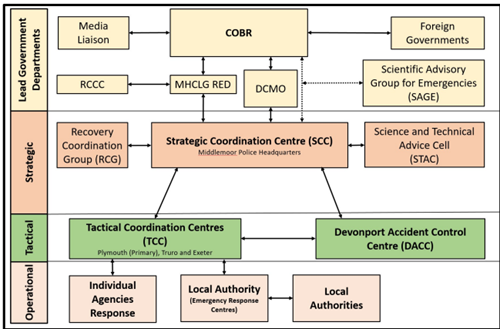Off-site Plan
Introduction
REPPIR-19 Regulation 11(1&2) states that: "(1) Where premises require a planning zone under either or both of regulations 8 or 9, the local authority must make an adequate off-site emergency plan covering that zone or zones. (2) The plan required by paragraph (1) must be designed to mitigate, so far as is reasonably practicable, the consequences of a radiation emergency outside the operator’s premises”.
The associated ACOP states that the plan must be a “written document or set of documents” and can be put into effect without delay.
There is more to this regulation detailing the minimum contents (reg 11(3) and schedule 6), consultation (reg 11(5)), training and equipping of responders (reg 11(6)) and reporting completion of the plan (reg 11(7)).
REPPIR Schedule 7 gives the principles that must be considered when an emergency plan is being prepared. These are:
(a) the necessity for the plan to respond to the particular characteristics of a given radiation emergency as those characteristics emerge;
(b) the necessity to optimise protection strategies to ensure that the proposed response, as a whole, is predicted to do more to mitigate the radiation
emergency and facilitate transition from that emergency than to increase its duration or consequence, taking into account—
(i) the health risks arising from exposure to ionising radiation as a result of the radiation emergency, in both the long and the short term;
(ii) the economic consequences of the radiation emergency;
(iii) the effects of the disruption, both on the premises and the area immediately surrounding it, and on the public perception of the effects of the radiation emergency;
(c) the necessity of avoiding, so far as possible, the occurrence of serious physical injury to any person or persons;
(d) the necessity of ensuring that an appropriate balance is struck between the expected harms and benefits of any particular protective action so as to maximise the benefit of that action.
The requirement to ''“respond to the particular characteristics of a given radiation emergency as those characteristic emerge”'' essentially states that the plan cannot simply say something along the lines of ''“if the emergency plan is initiated we will impose the following automatic protective actions until the event ceases”''. Instead the plan has to allow for the collection of information about the event (situational awareness), must have some form of decision making process to determine the appropriate actions and must have the co-ordinated resources to deliver the protective actions decided upon by the system. 1(b - d) requires people in the decision making process with some understanding of the balance between the steps that can be taken to avoid radiation exposure and the full range of costs that they entail.
The scope of the plan
The local authority determine the scope of their off-site plan from the Consequence Report provided by the operator and from subsequent discussions with the operator, other responding organisations and the regulators.
The purpose of the plan (REPPIR) is to:
a. to reduce or stop the effects of the radiation emergency (Largely the Operator's on-site plan)
b. to reduce the exposure to individuals and to the environment resulting from the release of ionising radiation
c. if necessary, to ensure that provision is made for the medical treatment of those affected by the radiation emergency and
d. to prioritise the implementation of the plan in relation to a person exposed to a dose consequence in excess of the reference levels set out in regulation.
Off-site plans achieve these aims by capturing the agreements about the roles and responsibilities of the different responders and how they will be alerted and coordinated, what protective actions might be needed and how they would be decided and enacted.
The plans also contain information such as contact details, population statistics, community facilities and transport links.
Strategic Coordination Centre
The key facility for the local authority off-site plan is the Strategic Coordination Centre (SCC). This is a large facility, often in the local Police headquarters where organisations can go to share information and coordinate their efforts. An idea of the size of these can be gleaned from the expected attendance list. The 2020 Torness off-site plan had:
EDF Energy
Government Decontamination Service
HM Coastguard
Office for Nuclear Regulation
Network Rail
Scottish Government
British Telecom
City Edinburgh Council
Police Scotland
Midlothian Council
NHS Lothian
Scottish Borders Council
Scottish Ambulance Service
East Lothian Council
Scottish Fire and Rescue Service
Public Health England/ Chemical and Environmental Hazards
Food Standards Scotland
Animal Health Plant Agency
Scottish Water
Scottish Environment Protection Agency
Scottish Power Energy Networks

You can learn more about the UK Concept of Operations for nuclear emergency response from Nuclear Emergency Planning and Response Guidance, Conops.